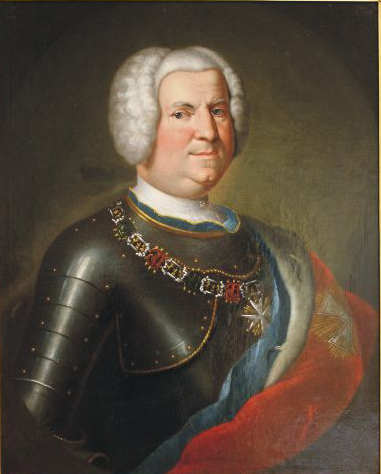by Susan Flantzer
© Unofficial Royalty 2023
The County of Waldeck was a county within the Holy Roman Empire since 1180. In 1625, the much smaller County of Pyrmont became part of the much larger County of Waldeck through inheritance and the combined territory was known as the County of Waldeck-Pyrmont. In 1712, Friedrich Anton Ulrich, Count of Waldeck-Pyrmont was elevated to Prince of Waldeck-Pyrmont by Holy Emperor Karl VI.
Friedrich, the last Prince of Waldeck-Pyrmont, abdicated on November 13, 1918, and negotiated an agreement with the government that gave him and his descendants the ownership of the family home Arolsen Castle and Arolsen Forest. Today the territory that encompassed the Principality of Waldeck-Pyrmont is located in the German states of Hesse and Lower Saxony
********************

Auguste of Schwarzburg-Sondershausen, Princess of Waldeck and Pyrmont; Credit- Wikipedia
The wife of Georg I, Prince of Waldeck and Pyrmont, Princess Auguste of Schwarzburg-Sondershausen (Albertine Charlotte Auguste) was born on February 1, 1768, Sondershausen, Principality of Schwarzburg-Sondershausen, now in the German state of Thuringia. She was the third of the six children and the second of the three daughters of Prince August of Schwarzburg-Sondershausen (1738 – 1806), the grandson of Christian Wilhelm I, a reigning Prince of Schwarzburg-Sondershausen, and Princess Christine of Anhalt-Bernburg. Auguste’s paternal grandparents were Prince August of Schwarzburg-Sondershausen (1691 – 1750) and Princess Charlotte Sophie of Anhalt-Bernburg. Her maternal grandparents were Viktor Friedrich, Prince of Anhalt-Bernburg and Princess Albertine of Brandenburg-Schwedt.
Auguste had five siblings:
- Prince Friedrich of Schwarzburg-Sondershausen (1763 – 1791), married his first cousin Catarina of Schwarzburg-Sondershausen, had one daughter
- Princess Katharina of Schwarzburg-Sondershausen (1764 – 1775), died in childhood
- Prince Wilhelm of Schwarzburg-Sondershausen (1770 – 1807), unmarried
- Prince Alexius of Schwarzburg-Sondershausen (1773 – 1777), died in childhood
- Princess Friederike of Schwarzburg-Sondershausen (1774 – 1806), married Friedrich Karl of Sayn-Wittgenstein and had three children

Auguste’s husband Georg of Waldeck and Pyrmont; Credit – Wikipedia
On September 12, 1784, at Otterwisch Castle in Otterwisch, Electorate of Saxony, now in the German state of Saxony, sixteen-year-old Auguste married 37-year-old Prince Georg of Waldeck-Pyrmont, the son of Karl August, Prince of Waldeck-Pyrmont and Christiane Henriette of Zweibrücken-Birkenfeld. Georg was the heir of his unmarried brother Friedrich Karl August, Prince of Waldeck and Pyrmont who reigned 1763 – 1812.
Georg and Augusta had thirteen children. Seven of their children died either in childhood or in their early twenties:
- Christiane of Waldeck and Pyrmont (1787 – 1806), Abbess of Schaaken, died at age 19
- Karl of Waldeck and Pyrmont (1788 – 1795), died in childhood
- Georg II, Prince of Waldeck and Pyrmont (1789 – 1845), married Emma of Anhalt-Bernburg-Schaumburg-Hoym, had five children
- Friedrich of Waldecka and Pyrmont (1790 – 1828), morganatically married Ursula Polle who was created Countess of Waldeck, had four children
- Christian of Waldeck and Pyrmont (1792 – 1795), died in early childhood
- Augusta of Waldeck and Pyrmont (1793 – 1794), died in infancy
- Johann of Waldeck and Pyrmont (1794 – 1814), died at age 20
- Ida of Waldeckaamd Pyrmont (1796 – 1869), married Georg Wilhelm Prince of Schaumburg-Lippe, had nine children
- Wolrad of Waldeck and Pyrmont (1798 – 1821), died at age 23
- Mathilde of Waldeck and Pyrmont (1801 – 1825), married Eugen of Württemberg, had three children, died during her fourth pregnancy
- Karl Christian of Waldeck and Pyrmont (1803 – 1846), married Amalie of Lippe-Biesterfeld, had one child
- Karoline Christiane of Waldeck and Pyrmont (1804 – 1806), died in early childhood
- Hermann of Waldeck and Pyrmont (1809 – 1876), married Agnes Teleki de Szék, had no children

Auguste in old age; Credit – www.geni.com
On September 24, 1812, upon the death of his childless elder brother Friedrich Karl August, Prince of Waldeck-Pyrmont, Auguste’s husband 65-year-old Georg succeeded him as Prince of Waldeck and Pyrmont. Georg had a short reign, dying on September 9, 1813. He was buried in the Princely Mausoleum at Schloss Rhoden (link in German) in Rhoden, Principality of Waldeck-Pyrmont, now in the German state of Hesse. Auguste survived her husband by thirty-six years, dying on December 26, 1849, aged 81, in Arolsen, Principality of Waldeck-Pyrmont, now in the German state of Hesse. She was buried with her husband in the Princely Mausoleum at Schloss Rhoden.

Princely Mausoleum (on the right) and Cemetery; Credit – www.findagrave.com
This article is the intellectual property of Unofficial Royalty and is NOT TO BE COPIED, EDITED, OR POSTED IN ANY FORM ON ANOTHER WEBSITE under any circumstances. It is permissible to use a link that directs to Unofficial Royalty.
Works Cited
- August von Schwartzburg-Sondershausen. geni_family_tree. (2021). https://www.geni.com/people/August-von-Schwartzburg-Sondershausen/6000000094312734890
- Flantzer, Susan. (2021). Georg I, Prince of Waldeck and Pyrmont. Unofficial Royalty. https://www.unofficialroyalty.com/georg-i-prince-of-waldeck-and-pyrmont/
- Wikimedia Foundation. (2023). Princess Augusta of Schwarzburg-Sondershausen. Wikipedia. https://en.wikipedia.org/wiki/Princess_Augusta_of_Schwarzburg-Sondershausen
- Wikimedia Foundation. (2023). Авґуста Шварцбург-Зондерсгаузенська (Augusta of Schwarzburg-Sondershausen). Wikipedia (Ukrainian). https://uk.wikipedia.org/wiki/%D0%90%D0%B2%D2%91%D1%83%D1%81%D1%82%D0%B0_%D0%A8%D0%B2%D0%B0%D1%80%D1%86%D0%B1%D1%83%D1%80%D0%B3-%D0%97%D0%BE%D0%BD%D0%B4%D0%B5%D1%80%D1%81%D0%B3%D0%B0%D1%83%D0%B7%D0%B5%D0%BD%D1%81%D1%8C%D0%BA%D0%B0
























